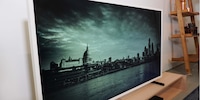
Hands-on: Elite Screens' motorised high-contrast canvas for UST projectors
This CLR canvas hits different. Not because of its price. But because it's motorised. That’s rare. If not unique. It also provides exceptionally good contrast. I'll explain why in today's hands-on review.
Spectrum. Saker Tension. Yard Master 2. No, these aren't Jaeger – towering human-powered robots fighting interdimensional monsters in Pacific Rim. They're all canvases. Canvases from Elite Screens. Cool, right?
The 100-inch canvas provided to me by the manufacturer for a hands-on test hasn't yet been given such a magnificent name. It's too new. It simply goes by «CLR FTE100H2». I'm sure they'll come up with a fitting title soon enough. Maybe. But the high price is already there.

Why is it so expensive? It's motorised and rolls itself up at the touch of a button. It also enhances any image’s contrast value. Finally: it's tailor-made for ultra-short throw projectors. This means any model that projects its image upwards onto a screen at close range. Ultra-short throw projectors – UST for short – haven't been around for that long. Screens specifically designed for them are correspondingly rare. Hence the high margins, which also lead to high prices.
So let's have a look at it, the CLR FTE100H2. Wow, it really needs a better name. I'll just call it Bob for now.
Why even get a canvas?
First things first: projectors need screens. Of course they do. Wait, why? Wouldn't a simple white wall serve just as well? Well, as you may have guessed, it's not quite that simple. Why else have this discussion?
Projectors, well, project light. Surfaces – generally speaking – reflect this light. And in pretty much every direction. Upwards, downwards. Left. Right. And so on. But you stare at the image head-on. Ideally, all the light from the projected image should hit your eye. This way no brightness is lost. After all, light that's reflected into the room and doesn't hit your eye is wasted brightness. The dimmer the picture, the more difficult it is for you to recognise any of it in a light-flooded living room.
Voilà: that's why you need a good canvas. Canvases have special surfaces. Depending on the material and texture, they ignore ambient light and reflect only the light that hits them head-on. From a projector, for example. Improved screens even enhance this reflection, much like a parabolic mirror. Making the image even brighter.
Good to have.
This canvas is... dark grey!?
Alright. Time to set up Bob the Canvas. This model is exceedingly rare here in Europe. That's why I only get to test it for one afternoon. Still, enough for a good first impression.
While unboxing it, the colour immediately catches my eye. It isn't white. That's surprising. Projectors use light. To make sure that the light projected is as pure as possible and that the colours aren't distorted, a white screen would be obvious, right? It's like creating an oil painting. Of course you’d use a white canvas.
Fun fact: cinema canvases aren't actually white at all. More of a silvery grey. And this motorised Elite Screens CLR canvas is even dark grey. This isn't your average projector screen. Bob is a high-contrast canvas.
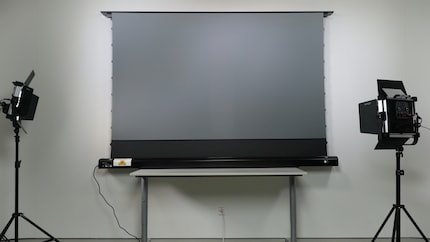
Why the dark grey? It helps to increase contrast. Hence the name. Contrast value describes the greatest possible difference between the brightest and darkest pixels. The greater this difference, the greater the contrast and the stronger the colours. Or to put it another way: the lower the contrast, the more faded the colours appear.
Ergo: you want your projector's image to have the highest possible contrast.
This is precisely why OLED TVs are currently sitting pretty at the top of the television industry. Their pixels can be switched on and off individually. This way they actually generate true black in any image. As a result, the difference between the darkest and brightest pixels in OLED televisions is immense. OLED contrast values are correspondingly superior – therefore improving the general image.
But projectors can’t project blackness. How could they? Darkness is naught but the absence of all light. Projectors only do light. So when you look at an image, black isn't really black, but rather the darkest possible projected picture. In a completely darkened room, a white screen would actually be black. But not during the day. Well now. The contrast would be ruined and the image would be way too faded.
In this way, it makes sense for Bob the CLR canvas to have a dark grey screen. Granted, the screen won't be completely dark in my bright living room. Still, better than white. What do you think? Accordingly, the black values and thus the contrast are better.
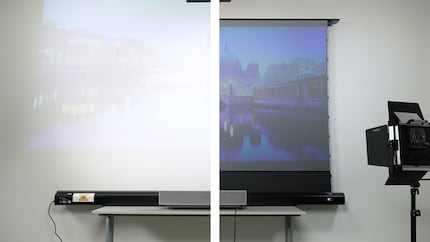
If you remember my oil painting example, you could now make the following argument: fine, if I paint on a dark grey canvas, the black values will be lower. Darker. But what about the picture as a whole? Where's the gain in terms of contrast enhancement?
Don't you worry, Elite Screens have thought of that as well.
Exclusive to ultra-short throw
Elite Screens use a material called «StarBright». The cloth is manufactured in such a way that it bundles light and reflects it more strongly. Akin to a parabolic mirror. This provides more brightness and balances out the dark grey. In addition, the screen only reflects light that comes from below. That's what the CLR stands for – «Ceiling Light Rejecting».
In concrete terms: this screen is only suitable for ultra-short throw projectors. Projectors that are directly underneath the screen. The dark grey canvas cloth is slightly ribbed. Think of the ribbing as tilted mirrors. Light that hits it from below is «reflected» forwards. Towards the viewer. Towards you. Ignoring all other light thanks to the angle at which the «tilted mirrors» are positioned in relation to the rest of the light. That's clever. Especially in a situation with a lot of ambient light, which would otherwise fade the image.
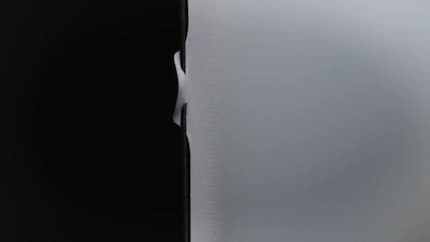
In addition, there's another feature: «Ambient Light Rejecting», or ALR for short. In plain English, this means the material ignores ambient light. This is important: have you ever wondered why most cinemas walls are black? It’s so that screen light isn't reflected off the walls – not even in the dark room that is the cinema. That would only add needless additional ambient light.
But your home's walls will hardly be black. Nor the furniture. The ambient light is therefore much stronger than in any cinema. The ALR feature is correspondingly important.
A great image despite motorisation
One last point. The motor. At the push of a button, the canvas rolls up automatically. This is exciting for anyone who doesn't want a black or dark grey hole in their living room all the time.
These kinds of motorised constructions aren't uncommon. They're only unusual on CLR screens that are explicitly made for ultra-short distance beamers. Most of the time, motorised screens don't have the necessary tension: if a projector is placed below the screen, even small bumps in the cloth could cause ugly shadows.
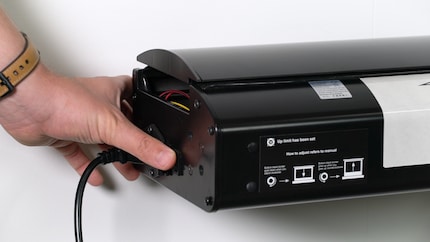
Apparently Elite Screens doesn't have this problem. Personally, I didn't notice any shadows during my test. Impressive.
All in all, it's pretty neat
Yes, Bob the Canvas is expensive. Almost as expensive as a good UST projector. This can be a deterrent. But there's logic behind the pricing.
- UST projector screens are rare.
- Motorised UST projector screens even more so, even without the added problem of tension.
- Not to mention that Bob increases contrast and ignores ambient light.
Still, the ugly name remains. Seriously. This canvas deserves something better than Bob or that gruesome jumble of letters and numbers. Herbert for instance. Or Wall Smasher 3000. Maybe you have an idea? I, for one, won't devote any more effort to alternate spellings.
I write about technology as if it were cinema, and about films as if they were real life. Between bits and blockbusters, I’m after stories that move people, not just generate clicks. And yes – sometimes I listen to film scores louder than I probably should.



